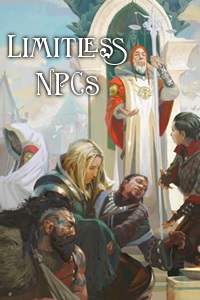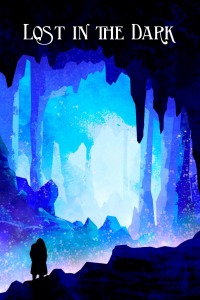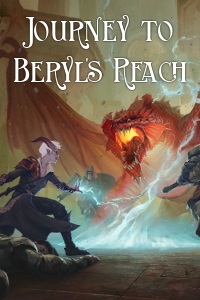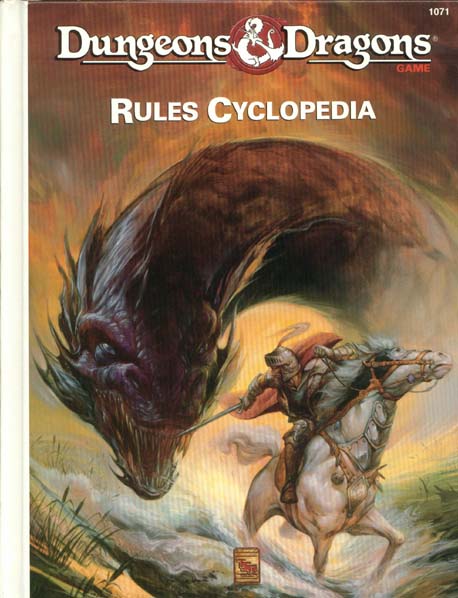Limitless Adventures specializes in D&D supplements aimed at helping a Dungeon Master add quality content to their home campaign while minimizing the amount of time they need to prepare for a game session. Their sourcebooks cover familiar topics, like NPCs, encounters, and monsters, but with added material designed to make those books useful in your game not just in the future, but immediately. That is to say, if you’ve got friends showing up in two hours and you need adventure materials, Limitless Adventures has you covered.
In addition to their plug-and-play style products, Limitless Adventures also makes solo adventures as well as 5th Evolution, a line of comic book style supplements that stretch the 5E rules into genres beyond medieval fantasy. These include super heroes, World War 2, 19th century horror, and more.
Interview With Andy Hand
I spoke with Andy Hand, co-founder of Limitless Adventures, about the history of the company and their design philosophy. According to Andy, he and Michael Johnson founded the company in 2015, following their yearly gaming campout. Andy says he and Michael set out to write the kind of D&D books that they would find useful in their home games. “Our business model has always been for gamers like us,” he says, “people who have to prep a game while handling the stress of work and home life. We endeavor to make it as easy as possible, while still being setting-neutral and interesting.”
Michael Johnson founded the company in 2015, following their yearly gaming campout. Andy says he and Michael set out to write the kind of D&D books that they would find useful in their home games. “Our business model has always been for gamers like us,” he says, “people who have to prep a game while handling the stress of work and home life. We endeavor to make it as easy as possible, while still being setting-neutral and interesting.”
That means content that can be slotted into an existing game with minimal work, whether the DM is using it for random encounter tables, a sandbox campaign, or just as a side-quest when the players go in an unexpected direction.
Who is Limitless Adventures?
Michael and Andy share the bulk of the writing, and split the day-to-day duties of running a game company. Of course, running a successful RPG publishing business takes more than just two people, and Andy notes that Limitless Adventures is supported in their work by a number of other people who help with social media, art, and special projects as needed.
Perhaps most importantly for a gaming publisher, they still make time to play D&D together on a weekly basis. Putting all those DM supplements to good use, one imagines.
What’s Inside a Limitless Adventures Book?
To understand Andy and Micheal’s philosophy in action, it’s helpful to crack open a Limitless Adventures book and take a look inside. Limitless Encounters, Vol. 1, for example, is a book that boasts 173 encounters, all written for the 5th Edition rules.
 The book divides its encounters by themed environments, like grasslands, forest, and haunted locales. Each encounter fits nicely on one (or sometimes two) pages. The idea is the DM can open Limitless Encounters to the appropriate environment, read the stat block and a couple of paragraphs, and then quickly get playing.
The book divides its encounters by themed environments, like grasslands, forest, and haunted locales. Each encounter fits nicely on one (or sometimes two) pages. The idea is the DM can open Limitless Encounters to the appropriate environment, read the stat block and a couple of paragraphs, and then quickly get playing.
Here’s an example encounter, taken from the Sea environment. It’s a single page encounter called “A Chat with Crixus” that details a run-in with a young bronze dragon who decides to land on the players’ ship as they’re at sea. The book lists the dragon’s combat stats, of course, but this encounter isn’t necessarily meant to be a fight. This dragon has an…unusual request. If the PCs can help him with what he wants, he’ll reward them with a treasure map.
In the spirit of low prep, there’s no requirement for the DM to actually draw this treasure map; the book handles it with a series of skill checks. Success means the PCs steer their boat to the treasure island. Failure means additional encounters, with the possibility of showing up at the right place but at the worst moment: just as the pirates are unearthing their ill-gotten doubloons!
Limitless Novelties
Limitless Adventures applies their low-prep, DM-friendly philosophy to all their books. In Limitless NPCs, they detail allies, enemies, merchants, and more. Limitless Monsters is a monster book, but it also offers tactics, lore for each creature, and pre-generated treasures.
Limitless Monsters is a monster book, but it also offers tactics, lore for each creature, and pre-generated treasures.
In addition, every Limitless Adventures book includes something the company calls a novelty. As Andy puts it, “since the publication of our first book, Limitless Encounters, Vol. 1, we have included a new element in each book, something that has not been published before; be it a new god, spell, magic item, or mechanic. Sometimes tabletop roleplaying games can fall into the trap of simply republishing material from previous editions. We work to break this bad habit with something novel in every book/product.”
5th Evolution Comic Books
Another interesting product the company offers is their 5th Evolution line of comic book-style supplements. Each of these books adapts the familiar 5E rules to a new genre, like 80s horror or super heroes, and presents them in a full color, comic book.
“For many gamers, 5th edition is their first step into the world of tabletop gaming. The 5th Evolution line seeks to take the game mechanics that players are familiar with, and apply them to new and exciting, non-fantasy genres,” Andy explains. “While we all love wielding a sword and fighting dragons, sometimes it’s fun to put on a cape instead. Each 5th Evolution book has a short comic that is intended to be shared with the players ahead of the game session. The comic ends in a cliff hanger, which is then resolved with a one-shot adventure. Each issue also contains enough material to write your own adventures in that genre.”
No Dungeon Master Required
Taking the idea of low-prep gaming to its extreme limit, Limitless Adventures also publishes adventures that require no preparation, and no Dungeon Master, at all. These include traditional, choose-your-own-path style solo adventures like Lost in the Dark. But Limitless Adventures also puts out some truly innovative adventures that you can play with a full group of players, but no DM.
 How does a group play with no DM? Andy explains:
How does a group play with no DM? Andy explains:
“Each player is assigned a color and given five encounter cards of five different types (combat, skill, roleplay, puzzle, and wildcard). Each card contains flavor text that sets the scene. Each player chooses a card and places it, face down, in a line on the table.
When a player’s card comes up in the initiative order, they flip it over, read it out loud to the party, and then turn to the corresponding page in the scenario guide where they’ll find all the information needed to run that encounter for the party. The player controls their character as they would any other NPC.
When the encounter is concluded, the next player in line takes over the responsibility of running the next encounter. The game continues round robin, everyone DMs, no one had to prep, no one gets stuck being the forever DM.”
Further Questions with Andy Hand
What was the inspiration behind the company? Why are you called “Limitless Adventures?”
Michael and I both have limitless imaginations. Each time we get together, we come up with a dozen new game/business ideas. The name is a nod to that, as well as our model of ready to use encounters that can be dropped into any campaign to provide adventures without end.
Tell me a bit about Limitless NPCs? Besides stat blocks, what tools do you give the DM to best make use of the different NPCs presented in the book?
The NPCs are divided by their role. Allies will adventure with the group and can help to round out any weakness in the party (lack of a healer for example). Contacts will aid the party, but not get their hands dirty (healing, information, etc). Foes, foils (not always villains) that come with four stat blocks to ensure they can be used during all four tiers of gameplay. Lastly, merchants will have their goods and services listed on a table with prices. Each NPC comes with a number of quest hooks.
Can you tell me a little more about Limitless Monsters? What sets it apart from, say, a more traditional monster book?
Each of our monsters has its stat blocks, pre-rolled treasure, tactics, lore, and adventure hooks. Additionally, we dissect the current Wizards of the Coast books to find underrepresented monster types, CRs, and themes.
books to find underrepresented monster types, CRs, and themes.
The description for Limitless Monsters Vol. 1 mentions “harvest mechanics”. Are those rules for harvesting monster parts as treasure or spell components, or something else?
Players love to use parts from the monster that they vanquish, be it making a potion from a body part, armor from the scales, or poison from a rare gland. We give the DM an example of something that can be harvested from a non-sentient monster and used by the players as an additional treasure.
The 5th Evolved Product Line is really intriguing. How do you adapt the 5E rules to genres as diverse as World War 2, Jack the Ripper, or superheroes?
We try to make each feel very different from D&D. In WW2, modern weapons are devastating. If you’re hit with a grenade or a machine gun, your adventure is likely over. With supers, we added a public opinion mechanic intended to keep players from falling back on the murder hobo habits of medieval fantasy games. In 80s horror, you’re just teens in a 1980s horror movie; your character is not a paladin or wizard. If you attempt to go toe to toe with the monster, you will be eaten. 5Evo challenges players to be creative and try new playstyles.
What’s a really clever encounter from one of your books that you’re most proud of?
Michael and I have written so many encounters over the years, and there are many that I love. The encounter “Riddles in the Dark”, in the dungeon chapter of Encounters Vol. 1 uses a mimic in a fun and different way. Additionally, the “When Worlds Collide” chapter of Encounters Vol. 3 shows DM how they can mix genres to create unexpected and fun encounters without falling back on tired tropes.
Are there any fun Easter Eggs in the Limitless Adventures books?
Oh, several. Past player characters and NPCs for sure. We tend to put our more supportive customers in our books as well. There are friends, family, pets, old flames, enemies…the list goes on.
What makes for a good side quest?
Pull in shared group history. DMs can get too hung up on creating history and backstory. What players want is to have the events that their characters were involved in highlighted in the side quest.
What’s your all-time favorite RPG book (any system or publisher)?
 I think that the Rules Cyclopedia (TSR, 1991) is the single greatest resource ever written. It had everything, and I do mean everything, that a DM would need to run a campaign from 1st to 31st level. It had monsters, magic items, a campaign setting, and player rules all in one stunning book. The illustrations in that book haven’t been matched since. It was perfection.
I think that the Rules Cyclopedia (TSR, 1991) is the single greatest resource ever written. It had everything, and I do mean everything, that a DM would need to run a campaign from 1st to 31st level. It had monsters, magic items, a campaign setting, and player rules all in one stunning book. The illustrations in that book haven’t been matched since. It was perfection.
What’s your favorite D&D class?
That’s a three-way time between fighters (my first character), wizards, and paladins.
